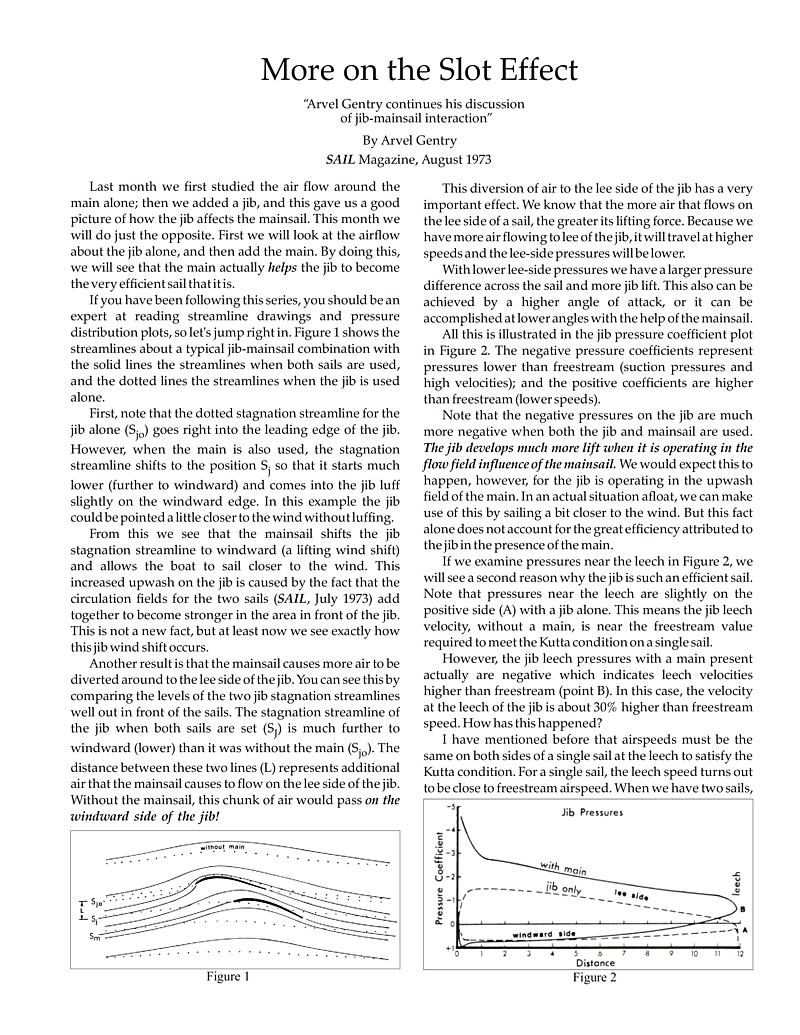Slot Effect
The effect of sails in combination is not simply additive. Two sails can be twice as effective as one sail or less than twice as effective. The combination of jib and mainsail in a Bermuda sloop is very common because these two sails form a particularly beneficial symbiosis. The governing aerodynamics of this happy union goes by the name of the slot effect, about which much—too much—has been written over the years. By now the warning bells should already have rung in your head: as soon as the word 'aerodynamics' is mentioned, you should anticipate conflicting claims and arguments over the physics of the slot effect. As always, I will banish detailed explanations, and also a brief summary of the common misconceptions, to the appendix. It is appropriate here, nevertheless, to at least state the cause and effect of 'the slot' because it is an important part of sloop performance.

Slot 2 - Beta - Memory Augmentation: Memory Slot 3 - Gamma - Neural Boost: Willpower Slot 4 - Delta - Cybernetic Subprocessor: Intelligence Slot 5 - Epsilon - Social Adaptation Chip: Charisma. Note: 'Simple' implants (those that only boost attributes) do not use Greek designations. Advanced attribute implants come in sets that affect one.

Airplane designers know all about the slot effect. The flaps on an aircraft wing, both at the front and the back, are control surfaces that permit the pilot to change the way that air flows over the wing. Staggered wings on an old biplane also influence each other. Way back in the 1930s Prandtl was able to write that 'the total induced drag of a biplane is smaller than that of a monoplane of the same span and of the same lift.'
Slats are aerodynamic surfaces on the leading edge of the wings of fixed-wing aircraft which, when deployed, allow the wing to operate at a higher angle of attack. A higher coefficient of lift is produced as a result of angle of attack and speed, so by deploying slats an aircraft can fly at slower speeds, or take off and land in shorter distances. Thanks For watching my video keep supporting me and like & subscribe my channel.: ) download illustrator file:- https://www.mediafire.com/download/zq58cpl.
* Symmetric spinnakers can be difficult to use and are hard work because they are flown only when the boat is running downwind and must be doused for other points of sail. The spinnaker of fig. 4.12 is symmetric (note the spinnaker pole that separates the mast from the spinnaker weather-side clew). There are also asymmetric spinnakers that can be deployed to windward. For downwind sailing there are also genoa foresails ('jennies'), which are large jib sails, and the so-called gennakers, which are genoa-spinnaker hybrids.
Apparent wind velocity
Apparent wind velocity
- Main
Figure 4.13. The slot effect is well known to airplane designers but has been understood in the context of sailing only within the last 40 years. On a windward point of sail, the jib influences, and is influenced by, the mainsail. The jib redirects the wind flow so that mainsail drag is reduced. The mainsail increases the jib's lift.
This fact may seem surprising, and certainly to someone schooled only in the Newtonian momentum flux ideas: the frontal area of biplane wings is greater than that of a single monoplane wing, so shouldn't the drag be greater? Well, no—that's aerodynamics for you. Explanations later. The important point is that drag is reduced, and the same thing applies to sails.
Jib and mainsail combine in the same way as the staggered wings of a biplane. When beating to weather, the combination is a very efficient sail plan. The typical orientation of jib and mainsail, and of apparent wind and heading directions, is shown in figure 4.13. The jib redirects wind on the lee side of the mainsail (jib and main form a 'slot' for the air passing between) so as to reduce mainsail drag. Another effect, surprising and perhaps counterintuitive, is that the mainsail influences jib performance. How can this be, given that the mainsail is mostly downwind of the jib? All explanation deferred.
All that the practical helmsman needs to know is that the mainsail's presence makes the jib a more effective fore-and-aft sail. If the jib has a mainsail behind it, the jib provides more lift than it would in isolation. When racing on a close haul, the helmsman 'shifts through the gears': he
Figure 4.14. Aerodynamics in action. The airplane wing provides vertical lift; the boats' triangular mainsails provide horizontal lift, whereas the foresails provide drag for downwind movement. What this picture does not reveal is the physics that applies underwater. Thanks to Simona Manca for this image.
Figure 4.14. Aerodynamics in action. The airplane wing provides vertical lift; the boats' triangular mainsails provide horizontal lift, whereas the foresails provide drag for downwind movement. What this picture does not reveal is the physics that applies underwater. Thanks to Simona Manca for this image.
repeatedly trims the jib and main as his yacht picks up speed. The jib is adjusted first because it influences how the mainsail should be trimmed, due to the slot effect.
Was this article helpful?
A leading-edge slot is a fixed aerodynamic feature of the wing of some aircraft to reduce the stall speed and promote good low-speed handling qualities. A leading-edge slot is a spanwise gap in each wing, allowing air to flow from below the wing to its upper surface. In this manner they allow flight at higher angles of attack and thus reduce the stall speed.[1]
Purpose and development[edit]
At an angle of attack above about 15° many airfoils enter the stall. Modification of such an airfoil with a fixed leading-edge slot can increase the stalling angle to between 22° and 25°.[2]

Slots were first developed by Handley Page in 1919 and the first aircraft to fly with them was the experimental H.P.17, a modified Airco DH.9A. Their invention is credited jointly to Sir Frederick Handley Page and Gustav Lachmann. The first aircraft fitted with controllable slots was the Handley Page H.P.20. Licensing the design became one of Handley Page's major sources of income in the 1920s.[3]
Slot Machine Effect
Similar, but retractable, leading-edge devices are called slats.[4] When the slat opens, it creates a slot between the slat and the remainder of the wing; retracted, the drag is reduced.
A fixed leading-edge slot can increase the maximum lift coefficient of an airfoil section by 40%. In conjunction with a slat, the increase in maximum lift coefficient can be 50% or even 60%.[2][5]
Unlike trailing edge flaps, leading-edge slots do not increase the lift coefficient at zero angle of attack since they do not alter the camber.[6]
Operation[edit]

A leading-edge slot is a fixed (non-closing) gap behind the wing's leading edge. Air from below the wing can accelerate through the slot towards the low pressure region above the wing, and exit from the slot moving parallel to the upper wing surface. This high-speed flow then mixes with the boundary layer attached to the upper surface and delays boundary layer separation from the upper surface.
Slots naturally exact a penalty on the aircraft in which they are used. This is because they contribute to drag compared to an unslotted wing.[7] The extra drag at low speed is acceptable because of the beneficial reduction in stall speed and improvement in handling characteristics, but at higher speeds the extra drag contributed by slots is a significant disadvantage because it reduces cruising speed and increases fuel consumption per unit distance flown.
One way to reduce the cruise drag of slots is to make them able to be closed. This arrangement is known as leading-edge slats. Aerodynamically, slats work in the same way as fixed slots but slats can be retracted at higher speeds when they are not needed. Slats, in turn, are heavier and more complex than slots.[4][7]
At low angles of attack the airflow through the slot is insignificant, although it contributes to drag. At progressively higher angles of attack, the flow of air through the slot becomes increasingly significant, accelerating from the higher pressure region below the wing to the lower pressure region on top of the wing. At high angles of attack the fastest airspeed relative to the airfoil is very close to the leading edge, on the upper surface. In this region of high local airspeed, skin friction (viscous force) is very high and the boundary layer arriving at the slot on the upper wing has lost much of its total pressure (or total mechanical energy) due to this friction. In contrast, the air passing through the slot has not experienced this high local airspeed or high skin friction, and its total pressure remains close to the free-stream value. The mixing of the upper surface boundary layer with air arriving through the slot re-energises the boundary layer which then remains attached to the upper surface of the wing to a higher angle of attack than if the slot were not there.[2] The leading-edge slot was therefore one of the earliest forms of boundary layer control.[2]
Application of leading-edge slots[edit]
Leading-edge slots are generally of two types: those that are full-span and those that are partial-span.[4]
Full-span slots are generally found on Short Take-off and Landing STOL aircraft like the Fieseler Storch, Dornier Do 27, PZL-104M Wilga 2000, and Zenair CH 701 STOL. Their primary purpose is to allow the aircraft to fly at a higher angle of attack before reaching the stalling angle.[8]
In aircraft other than specialist STOL aircraft, full-span slots have serious drawbacks because, to take advantage of the high angle of attack at the stall, they usually necessitate long undercarriage legs that either cause high drag or are longer than can be accommodated easily inside the airframe.[9]
Partial-span slots are usually found only on the outboard portion of the wing where they ensure airflow over that portion of the wing will remain unstalled at higher angles of attack than the inboard portions of the wing. This ensures the wing root stalls first and contributes to docile stall behaviour and maintaining aileron control throughout the stall.[2][4] Using slots in this manner produces a similar result to employing washout on a wing, but through a different means. Examples of aircraft with partial-span, fixed slots are the Stinson 108, Bristol Beaufort, Lockheed Hudson, and Dornier Do 28D-2 Skyservant.
See also[edit]
- Alula, a bird's biological equivalent to the leading-edge slot
References[edit]
Slot Effect In Sailing
- ^Kermode, A.C., Mechanics of Flight, Chapter 3
- ^ abcdeClancy, L.J., Aerodynamics, Section 6.9
- ^Centennial of FlightArchived 2012-10-10 at the Wayback Machine Retrieved 2008-02-19
- ^ abcdAviation Publishers Co. Limited, From the Ground Up, page 26 (27th revised edition) ISBN0-9690054-9-0
- ^Kermode, A.C., Mechanics of Flight, Figure 3.36
- ^Kermode, A.C., Mechanics of Flight, Figure 3.37
- ^ abAbbott and Von Doenhoff, Theory of Wing Sections, Section 8.6
- ^Crane, Dale: Dictionary of Aeronautical Terms, third edition, page 471. Aviation Supplies & Academics, 1997. ISBN1-56027-287-2
- ^Kermode, A.C., Mechanics of Flight, Figures 6.6 and 6.7
- Ira H. Abbott, and Albert E. Von Doenhoff (1959), Theory of Wing Sections, Dover Publications Inc., New York SBN 486-60586-8
- Aviation Publishers Co Limited: From the Ground Up, Twenty-Seventh Revised Edition. Aviation Publishers Co Limited, 1996. ISBN0-9690054-9-0
- Clancy, L.J. (1975), Aerodynamics, Chapter 6 High Lift Devices, Pitman Publishing Limited, London ISBN0-273-01120-0
- Kermode, A.C. (1972), Mechanics of Flight, Chapter 3 Aerofoils – Subsonic Speeds (8th edition) Pitman Publishing Limited, London ISBN0-273-31623-0
Effect Slot Menu Fl Studio
External links[edit]
| Wikimedia Commons has media related to Leading-edge slots. |
- 'Developments in Aircraft Design by the use of Slotted Wings' an article by Frederick Handley Page published in a 1921 issue of Flight